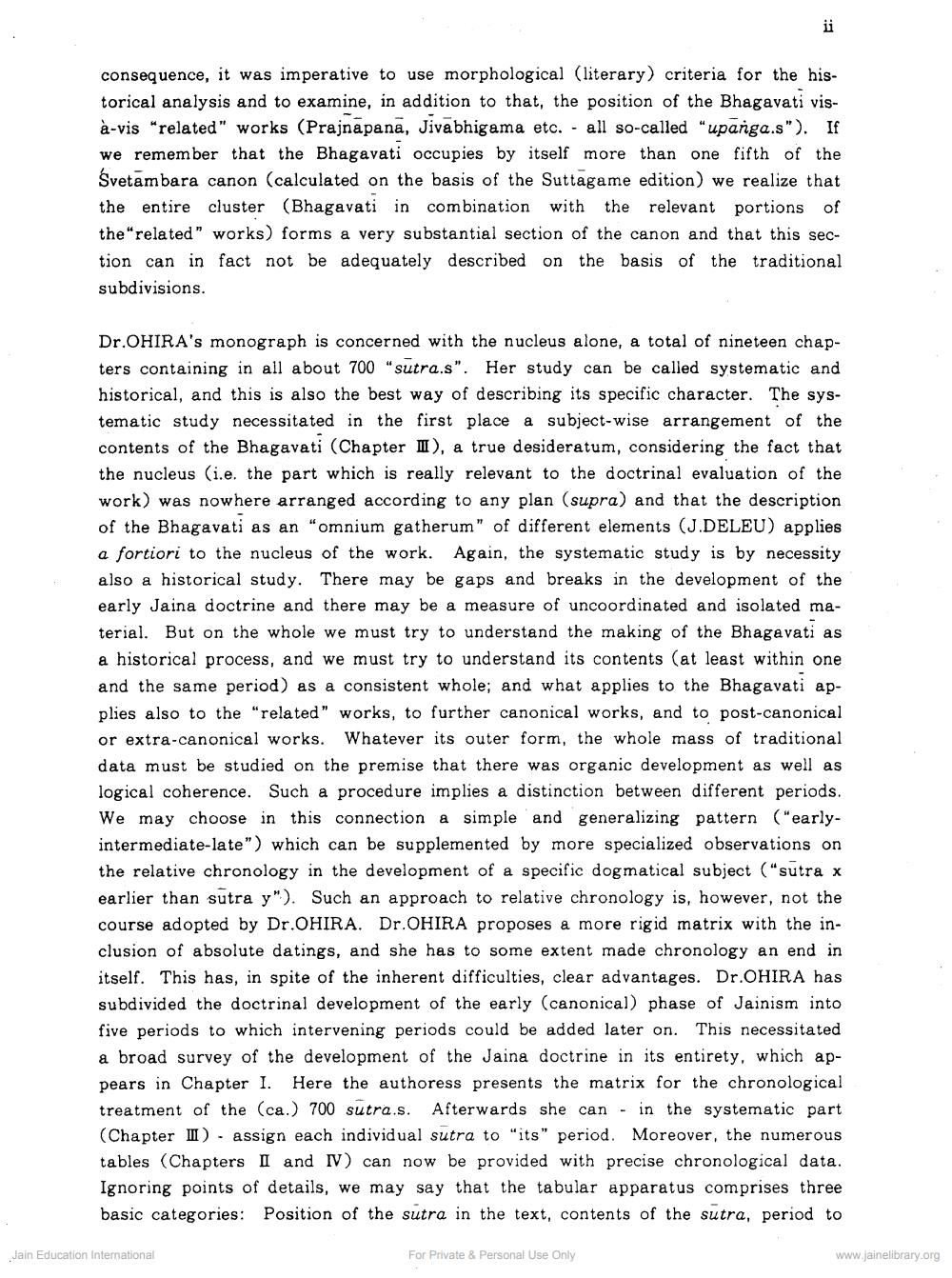Book Title: Agam 05 Ang 05 Study Of Bhagvati Vyakhya Prajnapti Sutra Author(s): Suzuko Ohira Publisher: Prakrit Text Society Ahmedabad View full book textPage 9
________________ consequence, it was imperative to use morphological (literary) criteria for the historical analysis and to examine, in addition to that, the position of the Bhagavati visà-vis "related" works (Prajnapana, Jivabhigama etc. - all so-called “upanga.s"). If we remember that the Bhagavati occupies by itself more than one fifth of the Svetambara canon (calculated on the basis of the Suttagame edition) we realize that the entire cluster (Bhagavati in combination with the relevant portions of the related" works) forms a very substantial section of the canon and that this section can in fact not be adequately described on the basis of the traditional subdivisions. Dr.OHIRA's monograph is concerned with the nucleus alone, a total of nineteen chapters containing in all about 700 "sutra.s". Her study can be called systematic and historical, and this is also the best way of describing its specific character. The systematic study necessitated in the first place a subject-wise arrangement of the contents of the Bhagavati (Chapter II), a true desideratum, considering the fact that the nucleus (i.e. the part which is really relevant to the doctrinal evaluation of the work) was nowhere arranged according to any plan (supra) and that the description of the Bhagavati as an "omnium gatherum" of different elements (J.DELEU) applies a fortiori to the nucleus of the work. Again, the systematic study is by necessity also a historical study. There may be gaps and breaks in the development of the early Jaina doctrine and there may be a measure of uncoordinated and isolated material. But on the whole we must try to understand the making of the Bhagavati as a historical process, and we must try to understand its contents (at least within one and the same period) as a consistent whole; and what applies to the Bhagavati applies also to the "related" works, to further canonical works, and to post-canonical or extra-canonical works. Whatever its outer form, the whole mass of traditional data must be studied on the premise that there was organic development as well as logical coherence. Such a procedure implies a distinction between different periods. We may choose in this connection a simple and generalizing pattern ("earlyintermediate-late") which can be supplemented by more specialized observations on the relative chronology in the development of a specific dogmatical subject (“sutra x earlier than sutra y"). Such an approach to relative chronology is, however, not the course adopted by Dr.OHIRA. Dr.OHIRA proposes a more rigid matrix with the inclusion of absolute datings, and she has to some extent made chronology an end in itself. This has, in spite of the inherent difficulties, clear advantages. Dr.OHIRA has subdivided the doctrinal development of the early (canonical) phase of Jainism into five periods to which intervening periods could be added later on. This necessitated a broad survey of the development of the Jaina doctrine in its entirety, which appears in Chapter 1. Here the authoress presents the matrix for the chronological treatment of the (ca.) 700 sutra.s. Afterwards she can - in the systematic part (Chapter II) - assign each individual sutra to "its" period. Moreover, the numerous tables (Chapters II and IV) can now be provided with precise chronological data. Ignoring points of details, we may say that the tabular apparatus comprises three basic categories: Position of the sutra in the text, contents of the sutra, period to Jain Education International For Private & Personal Use Only www.jainelibrary.orgPage Navigation
1 ... 7 8 9 10 11 12 13 14 15 16 17 18 19 20 21 22 23 24 25 26 27 28 29 30 31 32 33 34 35 36 37 38 39 40 41 42 43 44 45 46 47 48 49 50 51 52 53 54 55 56 57 58 59 60 61 62 63 64 65 66 67 68 69 70 71 72 73 74 75 76 77 78 79 80 81 82 83 84 85 86 87 88 89 90 91 92 ... 316
